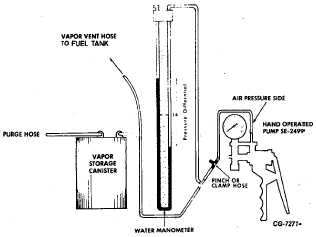|
| |
ENGINE DIVISION SERVICE MANUAL
TM 5-4210-230-14&P-1
Fig. 18 Method of Pressurizing Vapor Vent System to Check
for Leakage
Pressure test fuel tank vapor vent system by
disconnecting the hose on canister leading to fuel tank and
connect water manometer (SE-2217 or equivalent) and the air
pressure side of hand operated vacuum pump (SE-2499) as
shown in Figure 18.
Place sufficient water in manometer to allow 356mm
(14") differential in height. Pump the hand operated air pump
until a pressure of 356mm (14") of water is applied to the
system (indicated on the manometer). Pinch or clamp hose
between tee and air pump to keep system pressurized.
Observe manometer. If pressure drops more than 51mm (2")
of water in five (5) minutes, an excessive leak is indicated.
On a warm day it is possible to observe a pressure
rise due to evaporation of fuel. This indicates that system is
tight.
If excessive leakage is indicated, first check fuel tank
cap for a loose fit on tank filler neck or a damaged cap
gasket. If either of these conditions are found, replace cap. If
cap-to-filler neck fit and cap gasket are satisfactory, cover
relief valve opening in cap (small hole in portion of cap which
enters filler neck) securely with tape. Reinstall cap and again
pressurize system and check for leakage. If excessive
leakage persists, check all connections in fuel supply and
vapor vent system with soap suds solution to locate leaks.
Inspect for cracked or damaged fuel supply or vapor vent
tubes or connecting hoses. If no leaks are found and system
holds pressure with valve opening uncovered, it can be
assumed that relief valve in cap is faulty. Replace cap.
When pressure testing system following installation
of a new fuel tank, it will be necessary to disconnect and plug
fuel system line at fuel pump to prevent air leakage through
fuel pump and carburetor.
Air Cleaner Charcoal Rings
When engine is shut-off, gasoline vapors released
through the carburetor throats are temporarily trapped in
charcoal rings located in the bottom of the air cleaner. When
the engine is started the vapors are drawn from the charcoal
rings into the engine and burned. Damaged charcoal rings
should be replaced and installed with a silicone type adhesive.
Fuel Tank Cap
Fuel tank caps are nonvented to prevent passing of
gasoline vapors directly into the atmosphere.
Fig. 19 Fuel Tank Cap Relief Valve Operation
CGES-215 Page 13
PRINTED IN UNITED STATES OF AMERICA
|


